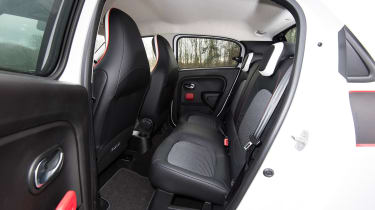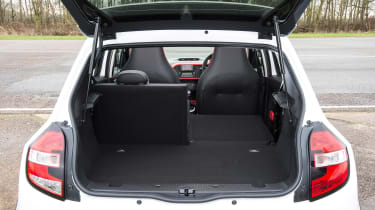Renault Twingo (2007-2014) review - Practicality, comfort and boot space
Don't be put off by its compact dimensions and quirky styling; beneath it all, the Renault Twingo is surprisingly practical
The Twingo is a tiny five-door hatchback with a Tardis-like interior for five people. Plus, the luggage area is highly practical and well thought out, even if it doesn’t offer class-leading space.
The driving position is relatively high, making visibility very good, and when combined with the tiny turning circle, this ensures the Renault is a doddle to drive in town. That’s not to say the driving position is perfect, though: there’s no seat height adjustment on the base model, and some Twingo owners have reported the footwell and pedals are too cramped.
On the positive side, there’s a whole host of storage spaces dotted around the cabin, including three cup-holders and a 6.4-litre glovebox. There are large rear door pockets (the Twingo has pop-out rear windows that don't need any space in the door to wind down into) and there’s also the option to add storage areas under the back seats for around £20. Meanwhile, heated front seats, with an Isofix child seat mounting on the passenger side, costs around £250.
Size
The Renault Twingo Mk3 is a considerably different shape to its predecessor, but it doesn’t have the smallest tarmac ‘footprint’ in the class. At 3,596mm in length, the car is 5cm shorter than the Hyundai i10, but 3cm longer than the Skoda Citigo.
The cars don’t differ much for width, but the Twingo has a clear advantage on height. Its 1,554mm roofline compares to 1,500mm for the Hyundai and 1,478mm for the Skoda.
Leg room, head room & passenger space
Thanks to its rear-engined configuration, the Renault Twingo has a 22cm longer cabin than its predecessor, even though the body is 10cm shorter. This benefits rear legroom, which Renault says is class-leading. Headroom is good, too, and even tall adults will have no issues fitting in the back of this city car.
More reviews
Car group tests
- Skoda Citigo vs Kia Picanto vs Renault Twingo
- Suzuki Ignis vs Renault Twingo
- Kia Picanto vs Renault Twingo & Hyundai i10
- Smart ForFour vs Renault Twingo and SEAT Mii
In-depth reviews
Long-term tests
Road tests
Used car tests
The only real problems are that the integrated front seat headrests make it hard for passengers sitting in the back to see the road ahead, while the pop-out rear windows don’t let in much fresh air; wind-down windows would be more welcome. Still, Isofix child seat mounts are standard in the back.
Boot
On paper, the boot doesn’t seem terribly impressive – although the numbers can be deceiving. With a capacity of 188 litres, the Twingo trails all its main rivals; even the Citroen C1 and Peugeot 108 have slightly more space, at 196 litres. But in practice, the Renault’s load area is more usable than most.
The rear-mounted engine has been positioned at an angle to keep it as low as possible, while heat-proof padding prevents heat from the engine bay cooking items in the boot. Designers have ensured there is no boot lip to lift stuff over, and when combined with the relatively square space, you can actually carry bulkier items in the Twingo than you can in the deeper boots of its rivals.
What’s more, you can lock the back seats in an upright position to increase available load space to 219 litres – although they won't be very comfortable for passengers travelling sitting there. And even then, the capacity is still way off the 251 litres in the Volkswagen up!.
Still, fold the rear seats down, and the total volume of 980 litres is second only to the Hyundai i10 in this class – thanks to the Twingo's taller body. Plus, the load bay is completely flat.
The Renault trumps the Hyundai, and every other city car for that matter, with its fold-down front passenger seat. Drop this right forward, and you can carry items of up to 2.3 metres in length inside the car – ideal if you need to transport flat-packed furniture, for example.






